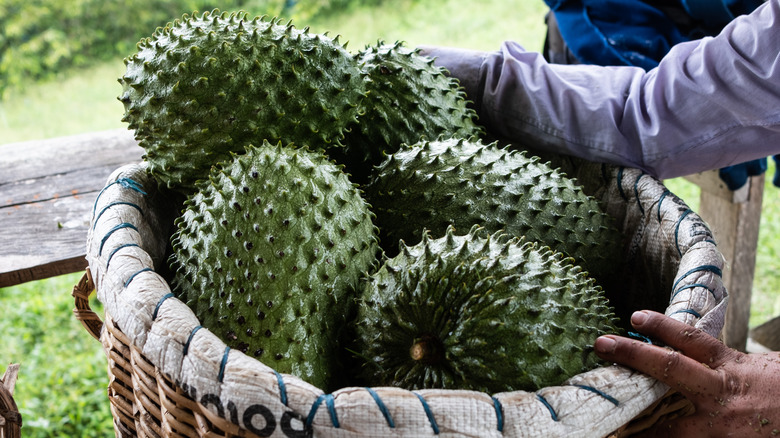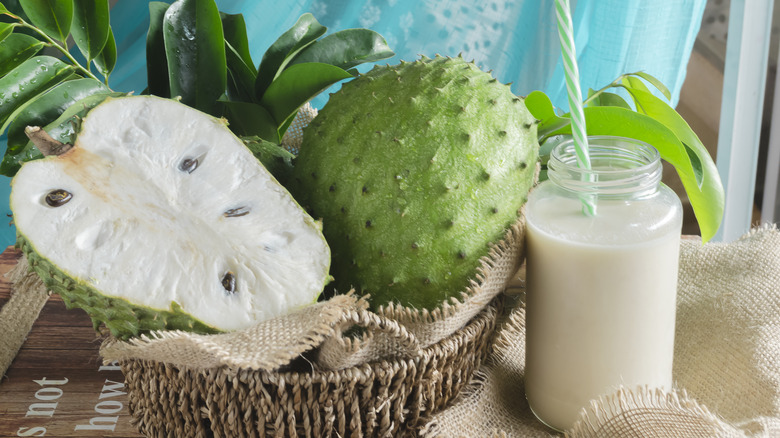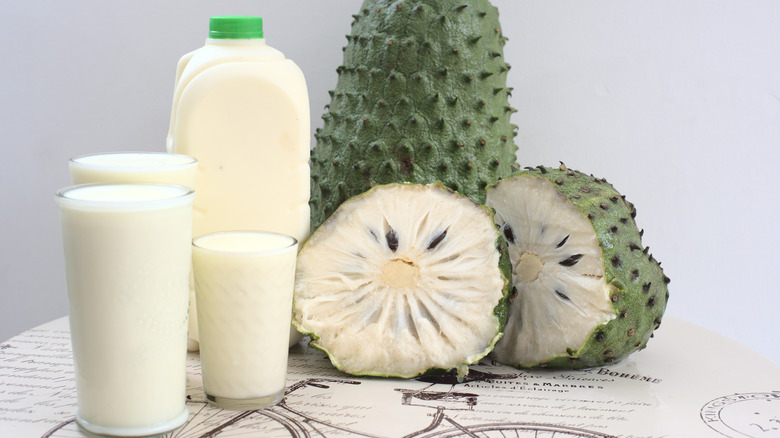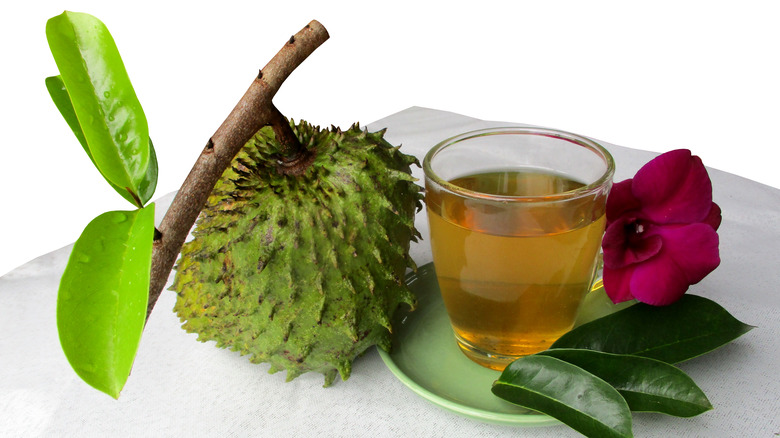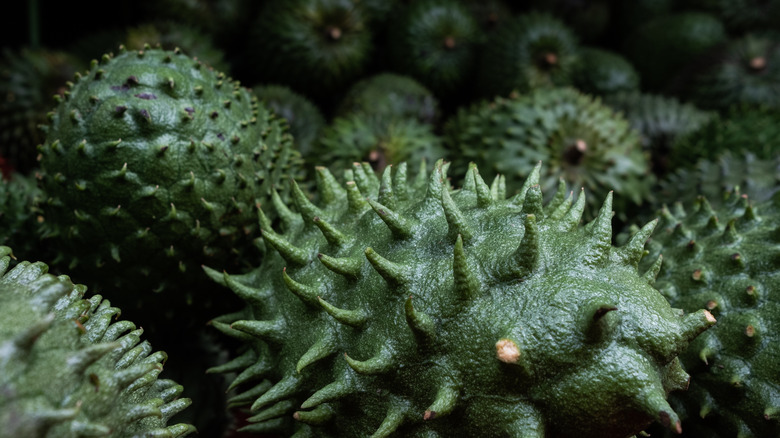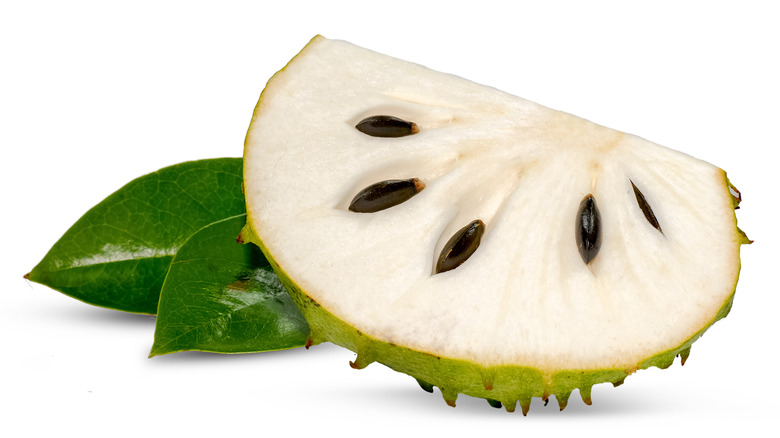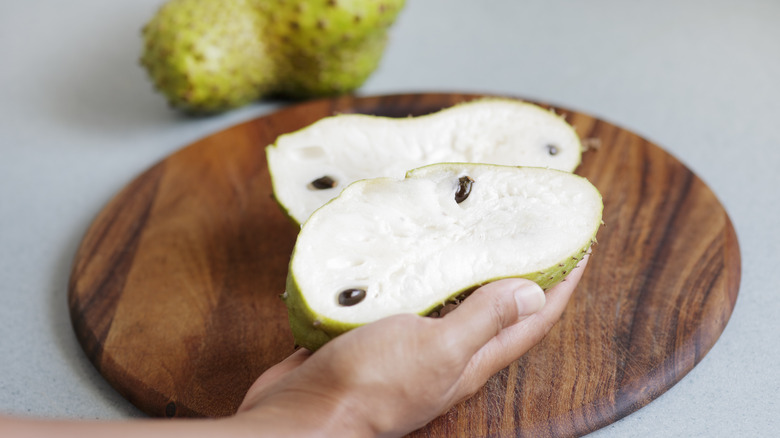What Is Soursop And What Does It Taste Like?
Soursop (Annona muricata) is a tropical fruit that is both cultivated and enjoyed across Southeast Asia, South America, the Caribbean, and the Pacific Islands. The heart-shaped fruit might not look too cuddly, but its spiky exterior hides nutrient-packed flesh full of vitamin C and fiber.
If you're a fan of cherimoya (Annona cherimola) or custard apples (Annona reticulata), you might have noticed the soursop's passing resemblance to both fruits, and that's because all three belong to the Annona family, which can grow in a different range of environments. But as the areas where soursop can be found suggests, the fruit is tropical, and even a few degrees of frost is said to be fatal for the plant that bears it.
Fans of fresh soursop will tell you you're in for a treat because not only does it taste like a hybrid of different tropical fruits, but soursop is also a great ingredient for ice creams, smoothies, and juices, making it the perfect go-to on a hot summer's day.
What is soursop?
It may have a prickly green exterior, but underneath its seemingly surly exterior, the soursop boasts of creamy white flesh that packs a flavor reminiscent of different tropical fruits. Soursop may have first been discovered in Central America hundreds of years ago, but it's been speculated that the plant stayed put until the Spanish conquistadores arrived in the Americas. After that, it may have traveled with the Spanish because it was sighted in the West Indies, North and South America, and in Southeast Asia.
In places where soursop is grown, the heart-shaped fruit is prized as a drink and a dessert, while others enjoy it as a vegetable cooked in various dishes. And while it may not be too well known in the U.S., it has its fans; celebrity chef Rick Bayless has waxed poetic about this fruit, calling it "ethereal" and has used it as a star ingredient in a signature cocktail, the Oaxaca Daiquiri.
What does soursop taste like?
In spite of its name, ripe soursop isn't sour but is, in fact, sweet and tangy. Its flesh is quite creamy, making it a great ingredient for smoothies and ice cream. And like some tropical fruits, the flesh of a ripened soursop can taste like the amalgamation of several different flavors you might have had before.
The flavor of ripe soursop has been described as a blend of banana, pineapple, coconut, and mango, with a bit of strawberry thrown in. In some countries like the Dominican Republic, soursop is also referred to as guanabana and is made into a refreshing beverage called champola de guanábana, which is made with sugar and water — it's heavy enough to be considered a snack or even a light dinner.
But like other tropical fruits like mango, papaya, and jackfruit, soursop can be consumed unripe, which changes its texture and flavor profile. Unripe soursop is said to have a potato-like texture with sour notes that sees the fruit live up to its name.
How to cook with soursop
Soursop has a creamy white flesh that is studded with black, inedible seeds, and because it is also a fibrous fruit, its meat can be a challenge to scoop out and eat as is. Because of this, its pulp is usually removed, then puréed before it is turned into a juice, smoothie, sorbet, or ice cream with the addition of a few ingredients like water, cream or milk, and sugar. When removing the pulp to freeze, remember to discard the seeds carefully, as they are toxic, per The University of Texas at El Paso.
While most food cultures that cultivate soursop enjoy it ripened, others consume it before it hits its prime. When this happens, soursop is not treated as a fruit but more like a vegetable. Indonesians use it to make salads, and in the Philippines, it is a common ingredient used in chicken soup. Brazilians are also known to prepare unripe soursop in different ways, from being fried, boiled, and roasted.
But its fruit is not the only bit of the soursop plant that is consumed. Its leaves are also used to brew a tea that is meant to help digestive problems like diarrhea. However, there are warnings not to consume too much of this non-caffeinated tea since excessive use has been linked to liver and kidney toxicity (via Verywell Fit).
Are there different varieties of soursop?
Because soursop can be found across several continents from South America to North Africa, it shouldn't come as a surprise that the fruit has several different names, including guanabana, guyabano, graviola, cabeza de negro, araticum de grande, and durian belanda. But the difference is more than semantic because there are slight variances in the different types of soursop as well — there are said to be 14 different types in Puerto Rico alone.
The variances between these cultivars of soursop depend on how much or how little fiber its flesh actually has. Still, the different types of soursop are all said to be classified under just one scientific name: Annona muricata L. Soursops generally start off with an inedible, dark-green peel anointed with soft barbs. That color then changes to a yellow-green as the soursop ripens, which takes between four to five days after the fruit is picked. A ripe soursop is said to be at its best when it is eaten up to two days after that.
Nutritional information about soursop
Soursop has a nutritional profile many fruits would be proud to have. A cup of the fruit's white, creamy flesh contains 148 calories, 7.42 grams of fiber, 37.8 grams of carbohydrates, as well as 30.5 grams of sugar, although it has a low glycemic index. The fruit is rich in vitamin C, potassium, magnesium, as well as plant antioxidants that are said to help your body fight diseases like cancer.
But while traditional medicine practitioners have touted the use of soursop as an antibacterial agent, as an anti-inflammatory, and to treat diseases including cancer, dietitians say these claims haven't been verified, and as such, there is no data on how effective the fruit actually is as a healer.
What has been studied, however, are the effects of taking too much soursop. Teas and supplements made with soursop shouldn't be taken because it interacts negatively with high blood pressure and diabetes medications. The Cleveland Clinic also warns too much soursop can even trigger symptoms that mimic Parkinson's Disease — these symptoms include personality changes and slower movements, as well as problems with the way you walk and your balance.
How to buy and store soursop
The fruit might be popular in Latin America, the Caribbean, and Southeast Asia, but it is less so in the United States, so it isn't likely to make an appearance in mainstream groceries. Still, it is possible to buy the fresh fruit online from specialty stores that sell produce from Latin America and the Caribbean, as well as from organic markets. If you can, make sure the fruit is dark green in color and without any blemishes. If fresh fruit is difficult to find, soursop juice and soursop concentrate can also be found online, at shops like Tropical Fruit Box or Miami Fruit. Both fresh soursop and concentrate can also be found on Amazon.
If you've been able to score a fresh, unripe piece of soursop, keep the fruit at room temperature to allow it to ripen. Once the fruit has softened, it should be ready to use, and it may be stored in the refrigerator for up to two days in a separate plastic or paper bag. If you decide to scoop its flesh out and freeze that to make smoothies at a future date, the soursop will last up to six months in super cold storage.
